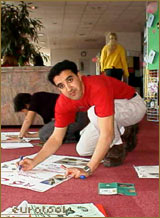Participants
Any youth exchange should have a minimum of 16 and a maximum of 60 participants - group leader's not included. National groups must be balanced in terms of numbers of participants.
The YOUTH program specially encourages the involvement of young people with less opportunities (from a less-privileged cultural, geographical or socio-economic background, or with disabilities). The participation of young people for whom it will be the first European experience will be encouraged.
In exceptional cases participants who are under 15 or over 25 may be included, if there are justified reasons and their number is strictly limited.
Group leaders
Each group should have one or more leaders (in accordance with national legislation or requirements for this type of activity). The representatives of the host and sending groups will be jointly responsible for carrying out and monitoring the project properly and for ensuring the active involvement of all participants.
Duration
The duration of the exchange activity should be between six and 21 days, excluding travel.
Project content
Non-formal learning experience
The project should contribute to the young people's education process and increase their awareness of the European/international context in which they live.
Theme
The starting point should always be the interest expressed by the young participants themselves. The exchange should have a thematic concept which the groups wish to explore together and which is directly related to the everyday experience of the participants. The chosen theme should, as far as possible, be translated into the concrete daily activities of the exchange. Examples of themes are music, films, local heritage, environment, information technology, racism, xenophobia and drug abuse.
Program and working methods
In planning an exchange, it is essential for a clear and structured program of daily activities to be established in detail. The daily program and working methods should involve the participants as much as possible and allow the learning process to evolve. The methods could include working in groups, field visits, simulation or role-playing games, round-table discussions, practical work, presentations, cultural or sports activities, etc. Most activities, however, should be linked to the main theme of the exchange.
Using various intercultural working methods not only provides the participants with an opportunity to explore several issues, cultures and identities, but can also ensure participation of all young people on an equal basis, regardless of their language abilities or other skills. For more information on methods and training courses, please contact your National Agency..
Intercultural dimension and impact at local level
Bringing together young people from different regions and countries can stimulate their awareness of other cultures and introduce them to new perspectives on familiar issues (history, perceptions of identities, etc.).
However, the impact of a youth exchange should not just be limited to the participants in the activity, but should also bring the concept of "Europe" to the local communities involved and promote more positive awareness of other cultures.
Preparation and follow-up
The preparation phase of an exchange is of crucial importance for the success of the project. During this phase, the participants should meet to discuss the objectives and theme of the planned exchange. Before submitting the application, the partner groups should agree on a program of activities, practicalities and common strategies to get to know each other. In some cases it is recommended that applicants envisage an advance planning visit to the host country and include it in the application. This visit should not take place until the application is approved and would normally last two days (travel excluded).
Right from the beginning of the project, the partners should think carefully about the follow-up to the exchange. For example, will the exchange be reciprocal? May a new partner be involved in the next project? After the exchange is completed, how can discussion of the thematic concept continue and what could the next steps be?
The follow-up issue should be dealt with during the evaluation sessions with participants before, during and after the exchange. The groups of young people should also reflect on how to pass on the experience gained to other groups as well as their local communities, etc.
 Selection criteria
Selection criteria